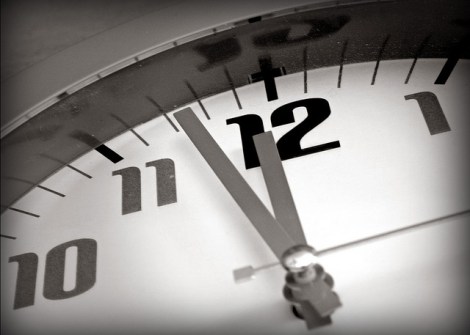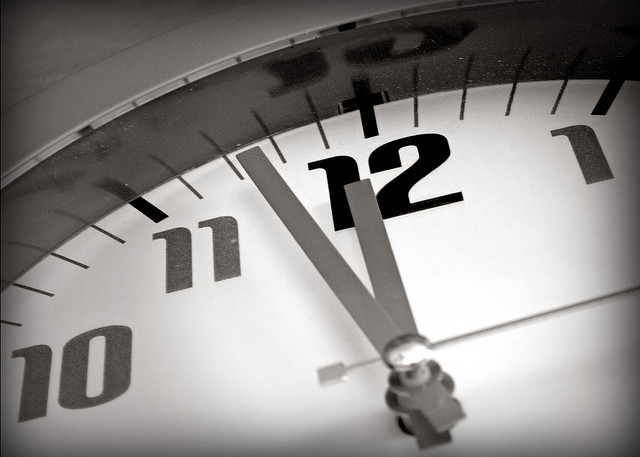
venosdaleThis clock — like all clocks — is wrong.
If you are asked what time it is, the answer is 11:55. If you are asked what happens at midnight, the answer is “all of humanity is destroyed and the Earth becomes the crumbling home planet of resilient insects until it is eventually consumed by the sun.” On the plus side, if you answer this way people will probably stop asking you what time it is.
Yes, our friends at the Bulletin of the Atomic Scientists (not a supervillain meetup) have decided that we are five theoretical minutes from our complete destruction — a determination that … doesn’t change from last year. So that’s good, I guess? From Live Science:
Keeping their outlook for the future of humanity quite dim, the group of scientists also wrote an open letter to President Barack Obama, urging him to partner with other global leaders to act on climate change.
The clock is a symbol of the threat of humanity’s imminent destruction from nuclear or biological weapons, climate change and other human-caused disasters. In making their deliberations about how to update the clock’s time this year, the Bulletin of the Atomic Scientists considered the current state of nuclear arsenals around the globe, the slow and costly recovery from events like Fukushima nuclear meltdown, and extreme weather events that fit in with a pattern of global warming.
I don’t really get why the clock didn’t change. We took more steps backward in 2012 than we did forward, according to analysis by yers truly. And isn’t the nature of climate change such that the threat of it automatically increases over time?
But that’s not my main complaint. My main complaint relates to this:
The Doomsday Clock came into being in 1947 as a way for atomic scientists to warn the world of the dangers of nuclear weapons. That year, the Bulletin set the time at seven minutes to midnight, with midnight symbolizing humanity’s destruction. By 1949, it was at three minutes to midnight as the relationship between the United States and the Soviet Union deteriorated. In 1953, after the first test of the hydrogen bomb, the doomsday clock ticked to two minutes until midnight.
The Bulletin was at its most optimistic in 1991, when the Cold War thawed and the United States and Russia began cutting their arsenals. That year, the clock was set at 17 minutes to midnight.
Why bother making the clock run from midnight to midnight if you’ve only ever used 17 minutes of it? I get that in 1947 they unveiled this thing and were like, “Guess what, motherfuckers: Time’s almost up.” But it seems like the schtick would grow old pretty fast. The first mention I could find of the clock was in this 1968 Times article. The story was four paragraphs, buried somewhere in the paper. The paper doesn’t specifically say, “This news caused us to shrug,” because journalists were more polite back then.
But anyway: Use the whole clock! Last year could have been, like, 10:37. And then this year, 10:52! Oh man, we’d think. Is it that late? And we’d probably also try to stop the clock from moving forward because we certainly don’t want the clock to go to 11:30 because that’s when Jay Leno comes on and he is the worst. Talk about a horrifying apocalypse, am I right? Of course, for all we know it’s 11:55 a.m.? Hard to tell sometimes on those old clocks that no one uses anymore.
According to the Bulletin of the Atomic Scientists, if a horde of alien destroyers appeared over the United States next week, alerting us that the planet was going to be destroyed to make way for an interstellar highway, the most the clock could advance is four minutes — meaning we’d be only .28 percent more likely to be destroyed than we are now. That seems like it’s probably wrong.
Anyway, gotta get going. Didn’t realize it was so late.


